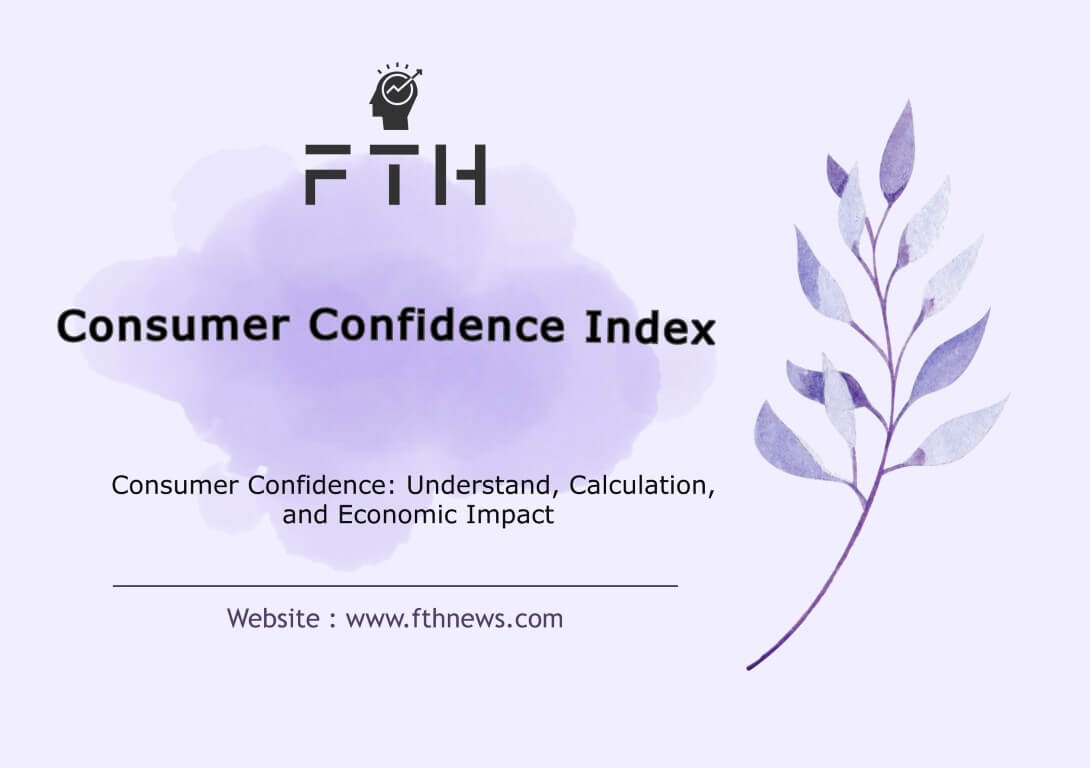
Consumer Confidence: Understand, Calculation, and Economic Impact
The Consumer Confidence Index stands tall as a pivotal economic metric worldwide, offering a glimpse into the collective optimism or pessimism of consumers regarding the economic landscape. At its core, this index reflects the confidence individuals have in the stability of their future incomes. Imagine someone anticipates a 10% growth in their current income over the next several years – that confidence translates into the ease with which they’ll readily consume the goods and services they require.
This influential index undergoes monthly assessments in various countries, drawing insights from a substantial sample size of two to five thousand consumer households. Its calculation reveals both the present economic state and a forward-looking perspective, shedding light on the anticipated future economic conditions.
To compute this index, households respond to five fundamental questions that delve into their perceptions:
- What is your assessment of the current state of the country’s economy?
- How do you foresee economic and business conditions in the next six months?
- Describe your existing working conditions and income.
- What are your predictions for work conditions, income, or unemployment in the next six months?
- What is your outlook on the overall family income in the next six months?
In broad strokes, during favorable economic conditions, consumers exhibit greater confidence in the future, fostering increased purchases. Conversely, in times of economic downturn, consumers tend to adopt a more conservative approach, focusing on savings and capital preservation.
This index, as one of the paramount economic indicators globally, significantly influences the determination of bank interest rates, stock market indices, and the strategic planning of commercial institutions. It’s worth noting that, to date, this index has not been calculated in Iran, and its potential impact on other indices remains unexplored.
Understanding the Consumer Confidence Index (CCI)
The Consumer Confidence Index, or CCI, stands as a pivotal gauge of economic sentiment, particularly in the United States, where it is rooted in a comprehensive survey involving 5,000 households. This survey, a cornerstone of economic analysis, is designed around five questions, two probing the current economic landscape and three delving into the prospective economic outlook.
The questions addressing current economic conditions focus on two key areas:
Assessment of the current state of the business: A measure of the perceived health and vitality of the business environment.
Assessment of the current job situation in the region: Providing insights into how individuals view the employment landscape in their locality.
Concurrently, questions related to future economic conditions explore the following themes:
Expectations for the business situation in the next six months: Anticipating the trajectory of business conditions over the short term.
about employment conditions in the next six months: Gauging optimism or concerns regarding future employment opportunities.
Expectations about the income of the whole family during six months: Offering a forward-looking perspective on the financial well-being of households.
Responses to these inquiries are categorized into three fundamental reactions: negative, positive, and neutral. This nuanced approach ensures a comprehensive understanding of consumer sentiment.
The CCI, as revealed through these surveys, emerges as a highly accurate confidence indicator and a leading economic metric. It holds significance not only in the United States but globally, serving as a crucial measure of consumer optimism regarding the economic conditions of society. Essentially, the index provides a window into the confidence each individual has in the stability of their future income. For instance, if someone is confident in a 10% growth rate in their current income over the next few years, they are likely to engage in increased consumption of goods and services.
This monthly calculation of the index, based on data collected from thousands of consumer households, effectively captures both the present and future states of the economy. The CCI, with its emphasis on consumer confidence, influences economic decision-making, shaping policies, and impacting various sectors, making it an indispensable tool in the realm of economic analysis.
How the Consumer Confidence Index (CCI) is Calculated
The Consumer Confidence Index (CCI) is a sophisticated metric that provides a pulse on Americans’ perspectives regarding both current and future economic conditions, offering valuable insights into their optimism about the economy and job prospects. Originating in 1967, the Conference Board birthed this index, initially sending out surveys twice a month and utilizing a distinct calculation method.
In its contemporary form, the CCI undergoes measurement through an online survey, with responses benchmarked against those from 1985. If the resulting index surpasses 100, it signifies heightened consumer confidence compared to the benchmark year. Conversely, a reading below 100 signals a dip in consumer confidence relative to the past.
At its core, the CCI functions as a specialized survey capturing consumers’ sentiments regarding the current and future economic climate. It serves as a litmus test, gauging the collective optimism or pessimism of Americans concerning economic conditions and job opportunities. Published on the last Tuesday of each month, the CCI has evolved into a widely accepted barometer, offering crucial insights into the strength and stability of the US economy.
It’s noteworthy that the CCI amalgamates two key indicators: the Current Situation Index and the Expectation Index, each playing a distinct role in shaping the overall assessment.
Current Situation Index:
This component assesses respondents’ perspectives on two critical aspects:
- Evaluation of the current state of the business: A measure of the perceived health and vitality of the business environment.
- Perception of job availability in the local area: Insights into how individuals view the current job market.
Expectation Index:
The Expectation Index delves into respondents’ predictions for the upcoming six months, encompassing:
- Anticipation of business conditions: Forecasting the trajectory of business conditions in the short term.
- Expectations regarding job availability: Gauging optimism or concerns about future employment opportunities.
- Outlook on personal income: Predictions about personal income over the next six months, whether it will increase, decrease, or remain steady.
Post-survey data collection, the obtained CCI values are compared against the baseline of 1985, a pivotal year when the index was first introduced. In 1985, the Consumer Confidence Index was set at 100, acting as a reference point. If the contemporary index exceeds 100, it signals elevated consumer confidence compared to 1985, while a value below 100 indicates a decline in consumer confidence. This nuanced approach provides a comprehensive understanding of the evolving economic sentiment over time.
The Dominance of Consumer Confidence:
Consumer confidence stands as the linchpin of demand in the US economy, exerting a profound influence on the economic trajectory. When individuals harbor uncertainty about the future, a natural consequence unfolds: reduced spending, thereby decelerating economic growth. Conversely, elevated confidence in the future fuels a surge in purchasing intent, consequently propelling consumer spending—a pivotal driver that constitutes a staggering 70% of the US GDP.
The delicate balance lies in the potential repercussions of an excessively buoyant consumer confidence. If confidence reaches unprecedented heights, individuals may divert from saving, opting instead to spend more. This surge in spending, while stimulating demand, can catalyze inflationary pressures. In response to this, the Federal Reserve may employ contractionary policies, typified by the elevation of interest rates, to rein in economic growth and mitigate the risk of inflation.
As the Federal Reserve enacts these contractionary measures, a ripple effect ensues, notably impacting the value of the US dollar. The strengthened dollar, in turn, manifests consequences on the international trade front. With a stronger dollar, exports may dwindle, while imports ascend. This dynamic shift in trade dynamics contributes to a moderation in the supply of goods and services, thereby curbing overall price increases and effectively controlling inflation.
In essence, the Consumer Confidence Index wields a commanding influence, serving as a vital barometer that not only reflects the prevailing economic sentiment but also guides policy decisions. Its ripple effects extend from shaping consumer behaviors to steering the course of economic growth, making it an indispensable factor in the intricate tapestry of the US economy. Understanding and responding to the nuances of consumer confidence is, therefore, pivotal for policymakers, businesses, and individuals alike as they navigate the ever-evolving landscape of economic dynamics.
Importance of Consumer Confidence Index for the Stock Market
Investors and stock market analysts closely track the Consumer Confidence Index (CCI) as a crucial indicator for anticipating shifts in consumer spending. The index serves as a window into whether spending is likely to increase or decrease, with an upswing potentially driving up company costs, boosting earnings, and elevating stock prices.
When the CCI rises, signaling increased consumer confidence, investors are often spurred to buy stocks. The stock market can experience significant movements on the day of the index release, representing a moment of heightened uncertainty about the economy. Investors eagerly embrace the new insights that the CCI provides, influencing their decisions in the market.
Does CCI Function Correctly and Usefully?
The Consumer Confidence Index operates with a high degree of accuracy, thanks to the meticulous methodology employed by the Conference Board. Monthly surveys, encompassing over 3,000 households with diverse demographic and socioeconomic data, contribute to the reliability of the index. While it stands as a useful economic indicator, it’s essential to acknowledge that, like all survey-based studies, the CCI remains an estimate. Nevertheless, monitoring changes in the CCI proves valuable for investors seeking informed perspectives on economic sentiment.
The Result of a Low Consumer Confidence Index
A decline in consumer confidence triggers reduced spending as individuals become less certain about their financial outlook. This downturn in consumer spending directly impacts businesses, leading to a decrease in sales. Faced with diminished confidence, individuals tend to save more and cut back on spending, causing a general decrease in demand for goods and services.
This decrease in demand can inflict serious damage on companies and business owners. If the trend of low consumer confidence persists, it has the potential to lead to stagnation, posing broader economic challenges. Acknowledging the implications of a low CCI is crucial for policymakers, businesses, and investors alike, as it offers insights into the potential risks and challenges that may lie ahead in the economic landscape.
The Reason for the Increase in CCI
Consumer confidence is intricately tied to the economic climate, often surging during periods of expansion and dwindling during contractions. When the economy is flourishing, and individuals or businesses have ample liquidity to make purchases or investments, the Consumer Confidence Index (CCI) tends to increase. This correlation highlights that a booming economy and robust liquidity contribute to heightened consumer confidence.
How the CCI Index Works
The neutral threshold for the CCI is set at 100 units. Readings below 75 are deemed alarming, indicating potential economic concerns, while figures above 125 signify favorable conditions. Consumer optimism or pessimism can influence interest rates and policy decisions. Heightened optimism might prompt the US Federal Reserve to adjust interest rates upward, whereas increased pessimism could lead to rate cuts as a measure to stimulate economic activity.
Final Word
The Consumer Confidence Index serves as a forward-looking gauge, anticipating future economic developments and reflecting people’s comprehension of the economy. Notably, the impact of economic changes may not be immediately felt by the majority for several months.
For instance, when a recession concludes, the effects are not immediately apparent to individuals. Many remain unemployed, in debt, and have faced housing losses, which impedes their ability to perceive improvements in the business cycle. This delayed realization is also evident at the onset of a recession when individuals may initially feel confident about job security and housing stability. It may take up to six months for the realization to set in that job opportunities are scarce, leading to financial strain and potential mortgage defaults.
Understanding the temporal lag in perception is crucial in grasping the dynamics of consumer confidence, shedding light on the challenges individuals face in navigating economic shifts.
What builds consumer confidence?
Consumer confidence is built through several factors, including:
Economic Stability: A stable and growing economy contributes to confidence as it fosters job security and income stability.
Employment Opportunities: Low unemployment rates and increased job opportunities enhance confidence in personal financial prospects.
Income Growth: Rising wages and income levels positively impact consumer confidence, enabling increased spending.
Stable Prices: When prices remain relatively stable, consumers feel more secure about their purchasing power.
Government Policies: Clear and effective economic policies instill confidence in the government’s ability to manage the economy.
Positive News and Sentiment: Media reports and general sentiment about economic well-being can influence consumer confidence.
Financial Markets: Stability and positive performance in financial markets can boost confidence in the overall economic health.
Consumer Protection: Strong consumer protection measures and fair business practices enhance trust and confidence.
Global Economic Stability: International economic stability contributes to a positive outlook, as global interconnectedness plays a role.
Personal Financial Health: Effective personal financial management, including savings and debt management, can positively impact confidence.
FAQ
Customer confidence refers to the trust and assurance a consumer has in a product, service, or brand. It’s the belief that their expectations will be met, leading to satisfaction and loyalty. High customer confidence often results in repeat business and positive word-of-mouth recommendations.
Consumer confidence level is the collective measure of optimism or pessimism among consumers regarding the economy and personal finances. High confidence indicates positive sentiment, while low confidence may lead to cautious spending.
An example of consumer confidence can be observed during periods of economic prosperity. For instance, when a country experiences robust economic growth, low unemployment rates, and rising wages, consumers tend to feel more optimistic about their financial prospects. In such a scenario, they may be more willing to make significant purchases, invest in homes or other assets, and contribute to overall economic activity. High consumer confidence is often reflected in increased consumer spending, which, in turn, supports businesses and fuels economic expansion














